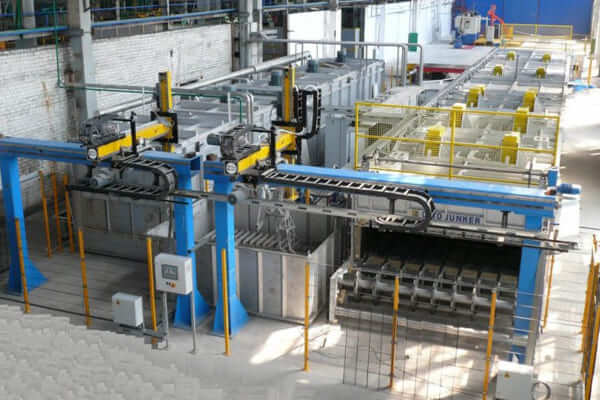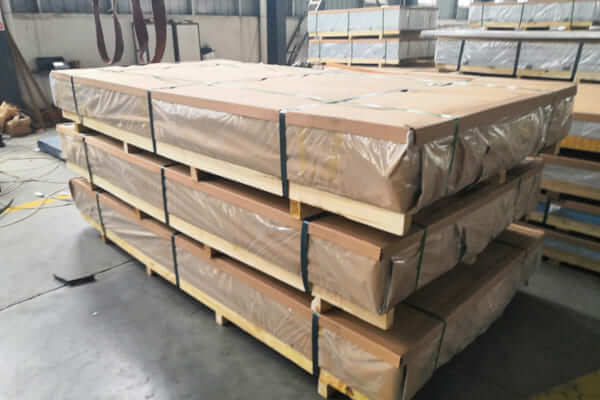Warmtebehandeling verwijst naar het regelen van de temperatuur van een deel of de gehele legering en de tijd op een bepaalde temperatuur, waardoor de microstructuur verandert en de eigenschappen van de legering veranderen.
Naast enkele gemeenschappelijke kenmerken van aluminiumlegeringen, zoals een hoge sterkte-gewichtsverhouding en sterke corrosieweerstand, de prestaties van verschillende legeringen zijn behoorlijk verschillend, en warmtebehandeling is ook een hulpmiddel om de prestaties ervan aan te passen.
Warmtebehandeling verwijst naar het regelen van de temperatuur van een deel of de gehele legering en de tijd op een bepaalde temperatuur, waardoor de microstructuur verandert en de eigenschappen van de legering veranderen.
Warmtebehandeling van staal – Het metaal verwarmen tot zeer hoge temperaturen.
Maar aluminium heeft een veel lager smeltpunt en een hogere thermische geleidbaarheid, wat een aanzienlijke invloed kan hebben op de manier waarop het opwarmt.

Heat treat of aluminum alloy
Sommige specifieke legeringen kunnen een warmtebehandeling ondergaan, niet alle aluminiumlegeringen kunnen een warmtebehandeling ondergaan;
In het algemeen, warmtebehandeling kan de prestatieparameters van aluminiumlegeringen verbeteren, zoals:
Legeringen die door warmtebehandeling kunnen worden versterkt, worden warmtebehandelbare legeringen genoemd, zoals:
De factor die bepaalt of de legering een warmtebehandeling kan ondergaan, is de chemische samenstelling van de legering. Sommige chemische elementen vertonen een hogere oplosbaarheid in aluminium bij hoge temperaturen, en de atomen kunnen opnieuw in de legering worden verdeeld om de verdeling uniformer te maken en de prestaties van de legering te verbeteren.
Onze meest voorkomende warmtebehandelbare legering is dat echter wel 6061 legering.
Er zijn vier veelgebruikte warmtebehandelingsmethoden voor aluminiumlegeringen;
Gloeien is een proces dat wordt gebruikt om enkele effecten van koud bewerken tegen te gaan (zonder het aluminium te verwarmen). Wanneer een materiaal koud wordt bewerkt, het creëert interne spanningen die de sterkte en hardheid vergroten. Echter, dit gaat ten koste van enige ductiliteit en vervormbaarheid, een effect dat werkverharding wordt genoemd.
Werkharding is noodzakelijk om de sterkte van het product te vergroten. Echter, indien het product vervolgens aan een verdere vormbewerking wordt onderworpen, de afname van de vervormbaarheid kan leiden tot verwerkingsfouten van het product.
Gloeien verlicht ook de interne spanningen in gegoten aluminium onderdelen om toekomstige scheuren te voorkomen. Het proces omvat het verwarmen van de legering tot een specifieke temperatuur, een bepaalde tijd vast te houden, en dan langzaam afkoelen tot kamertemperatuur.
Oplossingswarmtebehandeling omvat een verwarmingsproces dat lijkt op gloeien, maar in plaats van geleidelijk af te koelen tot kamertemperatuur, het product wordt geblust. Het afschrikken gebeurt meestal in water en 'bevriest' in wezen de microstructuur voordat de atomen zich opnieuw verdelen.
Na het blussen, aluminium kan verouderen. Afschrikken biedt ook een venster waarmee u door kunt gaan met verdere vormingsprocessen.
Oplossingswarmtebehandeling maximaliseert de concentratie van verhardende legeringselementen in vaste oplossing, zodat ze niet neerslaan voordat veroudering optreedt.
De ideale temperatuur om deze oplosbaarheid te bereiken ligt slechts enkele graden onder de smelttemperatuur van de legering. Vanwege het zeer smalle temperatuurvenster, Er moeten zeer nauwkeurige ovens worden gebruikt om de vereiste omstandigheden te bereiken en te behouden.
Wanneer een product een oplossingswarmtebehandeling heeft ondergaan, veroudering is een natuurlijk of kunstmatig proces. Het verouderingsproces verhoogt geleidelijk de sterkte en hardheid van de legering tot een hoger niveau dan het oorspronkelijke niveau.
Zodra het verouderingsproces begint, de microstructuur van de legering fixeert zich geleidelijk terwijl vaste oplossingselementen beginnen te precipiteren en zich in hun uiteindelijke posities vastzetten.
Natuurlijke veroudering betekent dat de meeste verharding binnenin plaatsvindt 24 uur behandeld, en het kan vier tot vijf dagen duren voordat het volledige effect optreedt. Echter, sommige legeringen kunnen door natuurlijke veroudering geen maximale sterkte bereiken, omdat hun vaste oplossingscomponenten niet volledig kunnen worden neergeslagen.
Deze legeringen vereisen verdere verwarming om volledige neerslag te bereiken, een proces dat kunstmatige veroudering wordt genoemd, ook wel neerslagverharding genoemd. De legering wordt op een bepaalde temperatuur verwarmd en vastgehouden 6 naar 24 uur, vervolgens afgekoeld tot kamertemperatuur. Het resultaat is een legering met verhoogde sterkte en hardheid, maar verminderde ductiliteit.
Het hoofddoel van het laatste warmtebehandelingsproces (homogenisering) is het herverdelen van de interne legeringselementen om uniformiteit in de chemische samenstelling van het product te bereiken. Dit is erg belangrijk voor gietstukken, die over hun hele dikte met verschillende snelheden stollen, beginnend bij de rand van de mal.
In dit proces, elementen met lagere smeltpunten, zoals puur aluminium, eerst stollen aan de buitenranden, terwijl elementen met hogere smeltpunten migreren en zich concentreren naar het midden van de gietwand.
Als er niets wordt gedaan, Sommige delen van het product kunnen te zacht zijn, terwijl andere gebieden mogelijk te hard en broos zijn, waardoor falen waarschijnlijker wordt. Om de aluminiumlegering te homogeniseren, het onderdeel wordt verwarmd tot een temperatuur net onder het smeltpunt en vervolgens langzaam afgekoeld.
Het verschil tussen homogeniseren en gloeien is dat homogeniseren bij een hogere temperatuur plaatsvindt. Gloeien herkristalliseert alleen door korrelgrensmigratie, terwijl homogenisatie ook de migratie van legeringselementen mogelijk maakt om uniformiteit van de chemische samenstelling door het hele product te bereiken.

Aluminum alloy warehouse
Bij het zoeken naar aluminiumlegeringen, de humeurtoestand is over het algemeen inbegrepen, en sommige temperatuuraanduidingen zijn gemarkeerd volgens de eerder genoemde specifieke warmtebehandeling. Dat is, de aanduidingen “O”, “W” en “T” geven respectievelijk aan of de legering is uitgegloeid, oplossing warmtebehandeld of verouderd.
O = uitgegloeid
W = oplossingswarmtebehandeld
T = ouderdom
Hun betekenissen zijn verschillend, maar een specifieke temperbehandeling vereist meestal een specifiek warmtebehandelingsproces;
Wanneer u klaar bent om een aluminiumlegering te bestellen of te gebruiken, het is het beste om de ontlaatnaam en het effect van ontlaten op de eigenschappen van de legering te onthouden.
Bij aankoop van aluminiumlegering, niet alleen om het legeringstype te bepalen, het legeringstype kan bepalen of de prestaties van de legering goed zijn, maar verschillende tempereringstoestanden hebben een relatief grote impact op de prestaties;
Ik zal u een voorbeeld geven om een probleem te illustreren. Bij aankoop van de getemperde staat van legering A en B, het is gebleken dat de getemperde toestand van legering C en D ook aan alle fysische en chemische prestatie-eisen kan voldoen. in grotere mate verbeterd kan worden.
De geschiktheid van warmtebehandeling voor uw product hangt af van de eindtoepassing en het productieproces dat u kiest. Omdat warmtebehandeling extra gereedschapskosten met zich meebrengt, U dient zorgvuldig te beoordelen of dit in uw situatie nodig is.
1060 aluminium stripkabels hebben een uitstekend draagvermogen, vooral zelfdragend vermogen. Een aluminiumdraad kan zo lang zijn als 4000 meter zonder te vallen, terwijl een koperen kabel alleen maar kan reiken 2750 meter.
6082 aluminium strip kan meestal een warmtebehandeling ondergaan voor een hogere sterkte, maar relatief lage ductiliteit.6082 aluminiumlegering is een van de legeringsmodellen van...
3005 aluminiumplaat behoort tot de Al-Mn-legering. De kracht van 3005 aluminium plaat is ongeveer 20% hoger dan die van 3003 aluminium plaat, en de corrosieweerstand is ook beter.
Aluminium platen met traanplaat 4x8 zijn verkrijgbaar in de maten 6061-T6 en 3003-H14. ze hebben een hogere sterkte, slijtvastheid, dragend, bewerkbaarheid, corrosieweerstand, enz. Daarom, populair in de bouw, productie, voertuigen, schepen en diverse velden.
Gepoedercoate aluminiumplaat verwijst naar de aluminiumplaat die is verwerkt door middel van een poederspuitproces;
Aluminiumfolie voor waterpijp wordt vaak gebruikt voor het bereiden en gebruiken van een waterpijp, ook wel shisha of waterpijp genoemd. Het dient een specifiek doel bij de bereiding van de waterpijp, met name bij de plaatsing en het beheer van de houtskool en tabak.
Nr.52, Dongming-weg, Zhengzhou, Henan, China
Henan Huawei Aluminium Co., Ltd, Een van de grootste aluminiumleveranciers in China Henan,We zijn opgericht in 2001 en hebben een rijke ervaring in import en export en hoogwaardige aluminiumproducten
Ma – Za, 8AM – 17.00 uur
Zondag: Gesloten
© Auteursrecht © 2023 Henan Huawei Aluminium Co., Ltd
laatste Reacties
Geachte heer, Please offer your best FOB Prices specs are as under ALUMINIUM STRIP (AL=99,50% MIN) MAAT:450 X32 X6MM. JOUW EEN 570 NL-AW 1050 A, AANTAL=3400KG
Hallo, Zou u zo vriendelijk willen zijn om het item als volgt aan te bieden: Spoel 0,6х1250 (1000)mm EN AW-3105 5tons
Hallo, Kunt u mij aluminiumplaten aanbieden?? Eigenlijk heb ik het nodig: 110mm x 1700 mm x 1700 mm 5083 H111 - 21 pcs Next year planed is 177 stuks
Geweldig artikel. Ik was blij verrast, dat ik dit artikel heb gevonden. Veel mensen denken van wel, dat zij over betrouwbare kennis over dit onderwerp beschikken, maar dit is vaak niet het geval. Vandaar mijn aangename verrassing. ik ben onder de indruk. Ik zal deze plek zeker aanbevelen en vaker terugkomen, om nieuwe dingen te zien.
eis van aluminium strip